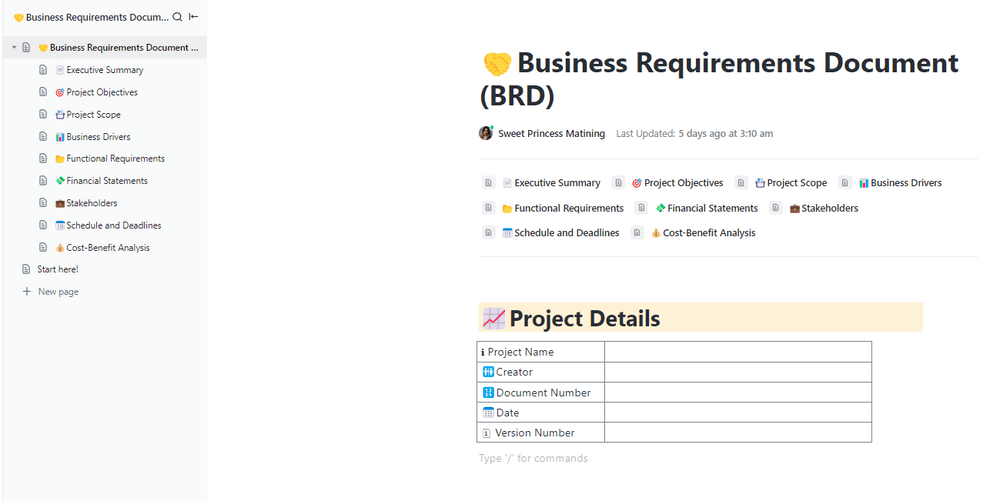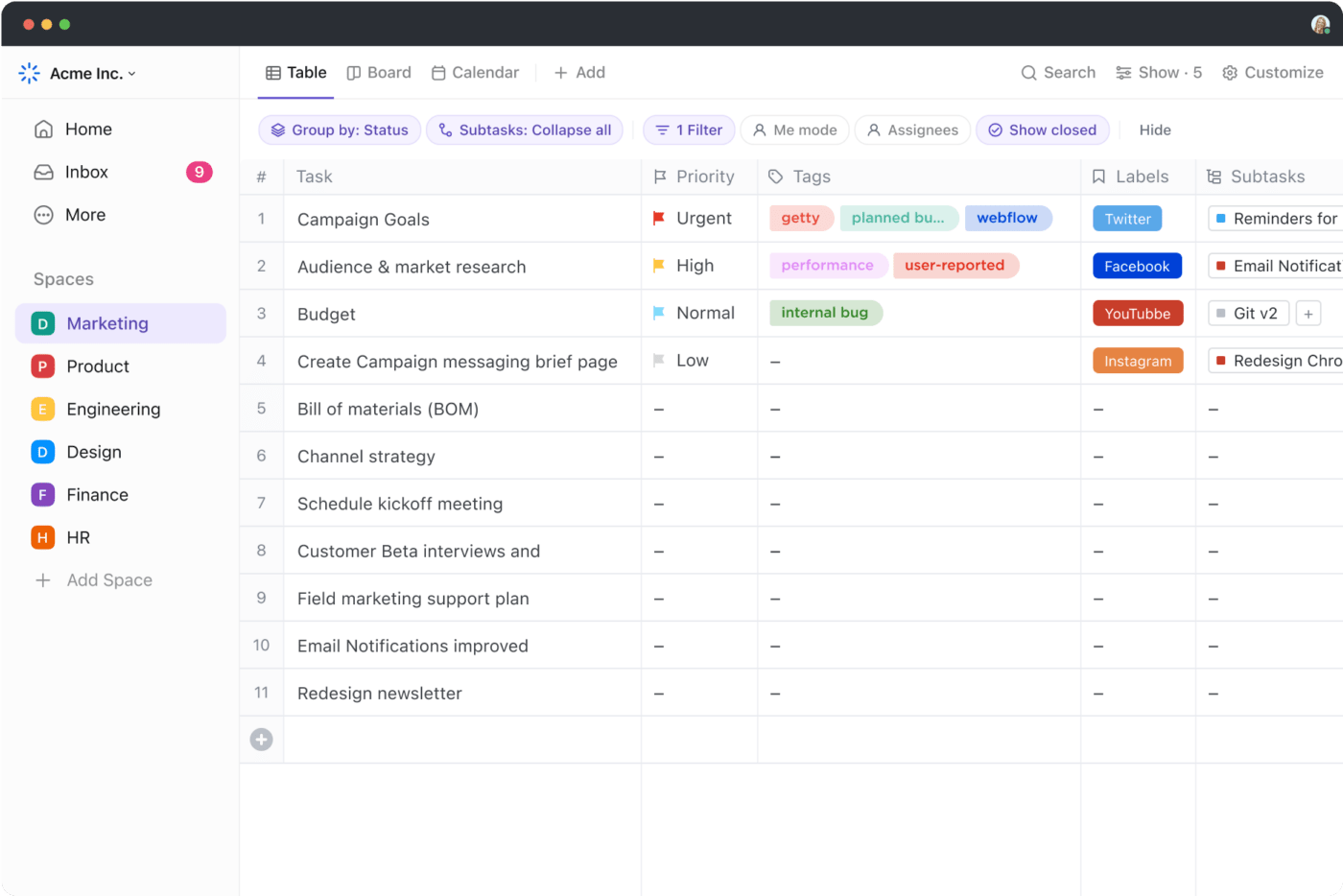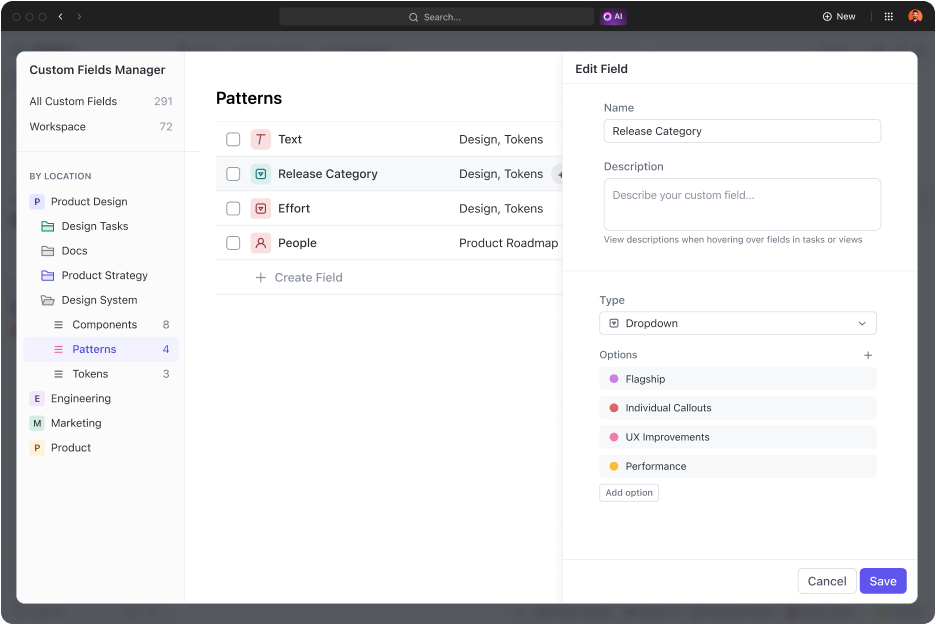

The key to successfully deploying a project is thoroughly understanding its output requirements and making a tangible effort to address them in the testing and reviewing phases. However, this is typically challenging because several many-to-many relationships exist within processes, often leading to delivery gaps and defects.
If you aspire to build the crème de la crème of products, a checklist won’t cut it. You’ll need a system that ties requirements to tests, tests to results, and issues to resolutions.
One way to ensure you’ve covered all bases is to compare the features of your final product with its initial requirements. But scouring through multiple documents to keep track of ever-shifting requirements is neither easy nor productive!
That’s precisely where a requirements traceability matrix (RTM) comes in, helping project managers keep team processes aligned with requirements in a centralized space. 😁
This comprehensive guide will help you:
- Understand requirements traceability matrices
- Create the matrix from scratch
- Leverage the best practices for the traceability process
What is the Purpose of a Traceability Matrix?
Tracing progress within projects from a granular lens has always been a backbreaking chore for project managers, especially in software teams. While any traceability-related to-do list helps you keep tabs on project organization tasks, it’s not of much use in the long run.
Here’s the deal—every decision or change in a stakeholder’s perspective within the project can shake things up and give rise to new requirements. This directly impacts the work of the testing team, with employees feeling lost in information and not knowing what to prioritize.
That’s where a traceability matrix brings no-fuss transparency to all stakeholders. It serves as a one-stop, grid-style business requirement document to help project and software testing teams:
- Plan project tasks as per current requirements
- Delegate tasks for optimized quality and delivery time
- Have a clear idea of the status of all the testing activities
- Avoid decisions that can mess with overarching project goals
A traceability matrix ensures that every core project task is ticked off, helping create a more solid and usable end product.
What is a Requirement Traceability Matrix?
A requirements traceability (RT) matrix or RTM is commonly used as an anchoring document in growing software projects.
When two or more project baseline documents must be correlated and their many-to-many relationships verified for completeness, the result is a requirements traceability matrix. It’s a useful tool for mapping out and linking your project’s initial requirements to the test scripts or cases that correspond to them, preventing missed or orphaned requirements in the process. 🌷
If you’re looking for a simple checklist, this is not it. An RTM is a detailed, living document to keep track of evolving project requests and finally provide a product that meets if not beats, initial user expectations. The change requests can come from users, specific stakeholders, or internal divisions like the sales department.
You’ll find RT matrices in the form of charts or tables with separate rows for each requirement and accompanying testing techniques. Depending on the industry you’re in, you can have sections for:
- Requirement ID
- Requirement description
- Justification or business need
- Test case ID
- Test result or execution status
- Test scripts
- Deliverable
- Work breakdown structure or WBS
- Notes
Types of Requirements Traceability Matrices
Traceability establishes links between requirements, processes, test cases, and final output elements. The tracing direction indicates how the correlation is established—whether in response to a requirement or an acknowledgment of it.
Based on the direction, you can expect three main types of traceability formats in matrices:
- Forward traceability: The requirement dictates a forward or future action, such as a test. It provides an overview of the project’s development from inception to completion ▶️
- Backward traceability: With backward traceability, you trace each test case back to a requirement. This ensures that every test is designed to prevent deviations from the scope of the project, as well as unnecessary actions ◀️
- Bidirectional traceability: A combination of both forward and backward models, it provides the most complete form of traceability. It supports the verification process of matching test cases with requirements 🔁
How to Create a Requirements Traceability Matrix: 5 Steps
As discussed above, a requirements traceability matrix is presented via a chart or a table. For many users, Excel stands out as a top choice for building the diagram, but it may not offer extensive support to jot down all the twists and turns a project might face.
Many product teams now prefer using project management software to develop versatile traceability matrices from scratch. It’s a quicker approach as these tools simplify the gathering and arrangement processes and offer real-time visibility of components to the entire team. So, think about accomplishing more than just the standard Excel spreadsheet—we’re talking:
- Tracking goals
- Creating documents capturing client requirements
- Compiling task lists
- Ensuring complete test coverage
- Customizing fields
- Reviewing all your work meticulously
All that, neatly put together in one place—ClickUp! 🤩

As a comprehensive project management software solution, ClickUp makes it easy for anyone to create a requirements traceability matrix within the tool. Plus, its practical communication and workflow planning features have your back across project phases!
Explore the five standard steps to create a useful requirements traceability matrix below.
Step 1: Compile RTM goals from different stakeholders
RTM goals are requirements collected from clients, internal teams, or other stakeholders. These goals could range from adding new features to your product to improving risk management.
Let’s say your project is about developing a fitness app focusing on user experience. In this case, the client highlights two key features: integrating personalized exercise plans based on user preferences and incorporating real-time tracking features to seamlessly monitor progress. The scope of this project is to provide a comprehensive fitness platform that meets individual needs and nurtures a health-conscious community.
Ideally, the project manager would compile the client’s business needs and then talk to the team to note down specific requests to materialize the output. Then, they’d break down each big goal into smaller, doable steps.
If you’re looking to map all your goals and requirements in one place, ClickUp Goals is the way to go. It helps you define RTM goals of any size and link them to specific stakeholders or assignees.
Once you set up your ClickUp Workspace, access the Goals page in the left sidebar by clicking on + New Goal. Once you’ve aggregated your goals, break them into smaller, measurable parts by creating Targets. The platform supports four types of Targets for matrices:
- Number: Track the increase or decrease within a range of numbers
- True/False: Marks a target as Done or Not Done
- Currency: Track changes to monetary goals
- Task: Monitors the completion of a single task, subtask, or an entire list

With ClickUp, you can create Folders and Sprints to track specific goals and even set up Milestones to highlight critical test matrix tasks and progress points.
Step 2: Gather project artifacts and define tasks
Project artifacts are the many documents, such as the project charter, change log, and project plan, that add character to your workflow processes. They form the core of your requirements traceability matrix, helping you connect test cases with the relevant artifacts.
This step aims to set your product or software testing team with all the contextual documents at their fingertips, allowing for a better insight into tasks, subtasks, and product backlogs.
Use ClickUp Docs to create and store all necessary project documents, test cases, and test results. Edit documents live with multiple team members, organize them in Folders, or link them to your RTM tasks—everything just CLICKS! 🥳

Need to save time on documentation work? Use ClickUp AI to generate well-structured project documents with just a few prompts! The platform also offers several readymade templates like:
- ClickUp Business Requirements Document (BRD) Template
- ClickUp Product Requirements Document (PRD) Template
- ClickUp Systems Requirements Template
- ClickUp Agile Team Roadmap Template
Once you’ve assembled your project artifacts, use Tasks in ClickUp to compile a list of the tasks and subtasks related to your traceability process. This will give you a better visualization of the network of deliverables that you’ll track through the test matrix. You can curate multiple task lists, each handling a specific requirement, and create dependencies to define the order of interrelated tasks.

Step 3: Create the matrix
Ready to build the RT matrix? 🏗️
Once you’re done with Step 2, pick the spreadsheet or charting tool to create the requirements traceability matrix. Here’s a rough outline of the steps to follow:
- Select which columns to include in your RTM. Do you need distinct requirement IDs, their descriptions, test case identifiers, or more?
- Plot the rows and columns based on the type of matrix. For example, in the case of forward traceability, the rows and columns would represent requirements and test case IDs, respectively (you may want to color-code everything for smoother traceability)
- Create links between requirements and related parameters within the matrix
The point is to have a visual, single-window interface to map out the relationship between different requirements and tick off completed goals.
If you’re comfortable with spreadsheets, the ClickUp Table view can be an excellent tool to customize your RT matrix at any scale! Add as many columns as you want, create Custom Fields for information, and use drag-and-drop actions to modify your RTM.

If you prefer rich visualizations, you can also explore ClickUp’s infinite Whiteboard to draw connections between requirements and test cases.
For that extra boost, leverage ClickUp’s diverse matrix templates to create your RTM. Our favorite is the ClickUp Traceability Matrix Template. Use it to chart connections systematically, sharpening your ability to:
- Determine the relationship between requirements and test results
- Visualize the changes that have taken place across the project development lifecycle
- Understand the reasoning behind certain decisions

Step 4: Start using the RTM
You should have the matrix structure and relevant headers at this stage. All you have to do is fill in the RT matrix! 📝
You can start by mapping test cases with your testing team and ensuring everything from the backlog is addressed.
One of the many perks ClickUp offers is that you don’t need to copy-paste or move back and forth between backlogs and task checklists. You can just move all previously created lists to your RTM with all their details, and they will be displayed in any view you choose.

For example, you can use the List, Board, or Calendar view to get a bird’s-eye view of all the tasks underway, categorized according to their Custom Status, such as Passed, Failed, or On Hold. View interdependent tasks and handle capacity planning using the Gantt Chart and Workload views.
The platform also enables seamless inter-department communication channels through the Chat view, assignable comments, and workflow proofing tools, ensuring no requirement is abandoned!
Step 5: Review, validate, and maintain
Think of the requirements traceability matrix as a document that’s always changing. As things shift around, like requirements dropping or new test cases popping up, you’ve got to adjust the matrix to keep everyone in the loop.
Remember: The initial requirement ID number stays the same even if you rearrange things around or use them again. ⚠️
Dashboards in ClickUp will help you review the results and track project performance through testing metrics. Use the customizable solution to:
- Distribute team tasks easily, discussing blockers and tracking progress
- Visualize resource allocation, identifying efficient and inefficient areas
- Assess goals through task completion, project time tracking, and workflow analysis in a secure control center

Tracking the percentage of completion of projects becomes easy with these Dashboards. Plus, you can also use Automations in ClickUp to receive automatic notifications or update the status of tests across the board without much manual intervention.
Benefits of Requirements Traceability Matrix in Project Management
A requirements traceability matrix is more than just a technical document. Let’s see some of its most notable benefits:
- Decision-making support: The RTM gives you a neat view of how different project requirements connect. Plus, when a requirement shifts, you can analyze how it ripples through development, facilitating well-rounded decision-making
- Smooth change management: When deliverables change in the project, the RTM keeps track of it all so that tweaks or updates are well-documented and accessible
- Risk management: By connecting requirements to tests, the RTM helps catch possible problems or missing links early on, giving you a heads-up to fix things fast
- Improved rules compliance: In industries with strict rules and regulations, the RTM ensures you follow them. It helps verify that your project sticks to the set requirements, keeping your business compliant
- Conducting the right tests: The RTM serves as a guide to the quality assurance team, displaying what needs testing and linking tests back to their exact requirements. So, QA teams run the tests that truly matter efficiently
Best Practices for Requirements Traceability Matrix
Even if you get the best project management tools, you may still face some obstacles and restrictions while creating the matrix. Luckily, they can easily be avoided if you stick to these RTM best practices that enable you to incorporate the approach without a hitch. 💪
Create a systematic list of needs
All project requirements need to be well-written and arranged logically and systematically while drafting an RTM. It helps teams determine if test scenarios, requirements, and other artifacts align suitably to plug traceability gaps during testing.
Use distinct IDs
To make connecting needs and test cases easier, take extra care to see that each requirement in the traceability matrix has its own unique code. This way, teams can manage changes, enhance error detection, and trace and evaluate the relationships between various components. This is essential if you want to obtain diverse systems when trying to combine test management tools and traceability matrices.
Set priorities
When prioritizing needs, you are in a more efficient position to allocate resources for testing and developing the most important features by focusing on high-priority requirements first. Early in the development process, teams can minimize project risks, identify possible problems, and produce high-quality products.
Tip: Use ClickUp Priorities to add color-coded priority labels to your tasks!

Keep your RTM up to date
Regular RTM updates are important in tracking project progress and managing modifications. Doing so reduces the risk of data inconsistencies and implementation gaps.
Encourage teamwork among employees
When it comes to requirements visibility, ensure that the testers, developers, business analysts, and developers are all on the same page. This will promote efficient communication and teamwork and also support decisions that yield excellent outcomes.
ClickUp’s Universal Search feature ensures that your project artifacts and traceability matrices are accessible to stakeholders with a single click. You can tweak the permission settings of individual documents if you need to keep certain files private.

Win Big: Manage Your Requirements Traceability Matrix with ClickUp
39% of projects fail due to a lack of proper planning and resource tracking, and you certainly don’t want your project to be part of this statistic. Don’t worry, you won’t be!
We promised a big win with ClickUp, and the big win is what you get! 🏆
Different views, Custom Fields, 1,000+ integrations, tracking features, and more—you get all useful features for free! Sign up to build your RTM matrix today!



